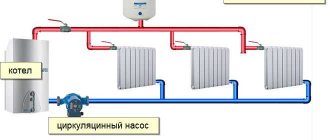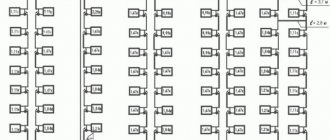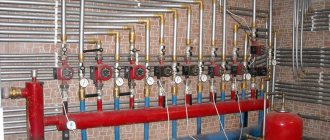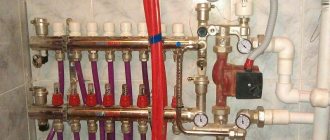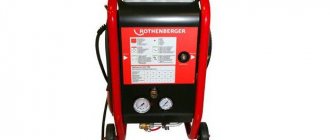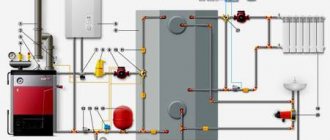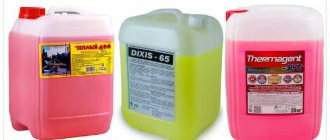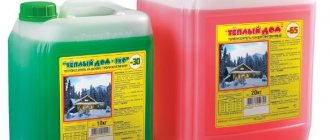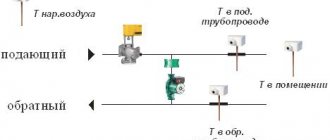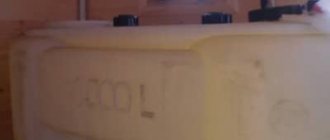Heat accumulator design
According to this scheme, the interaction between the heat accumulator, the boiler and the heating system occurs. As you yourself understand, it is quite difficult to manufacture any device without knowing exactly its entire “composition”.
Therefore, first we will carefully consider its main components, and only then we will proceed to the debriefing. So, a heat accumulator is, in fact, a huge thermos that can maintain the temperature of hot water for a long time (up to several days). It is based on a large iron barrel with good thermal insulation, and of course the necessary outlets.
Main components of the heat accumulator:
- The tank is the container itself where the hot water will be located.
- Thermal insulation is a layer of insulation that will prevent the water from cooling down.
- External casing - fits over the thermal insulation to fix it more securely and give your homemade device a presentable look.
- Shut-off valves
- Air vent
- Safety valve
- Thermostat or three-way valve
- Thread on the coil
- Thermometer - mounted in a sleeve to give the most accurate readings of the temperature inside the container.
- Electric heating element - of course it will be better if this part is present in your heat accumulator. It will play the role of a backup energy source in case the boiler is unable to function for some reason. Then, in severe frosts, the system will not defrost completely while you are repairing the heating unit. By the way, you will only need a heating element with a power of about 1.5-2 kW. Agree, a very necessary thing!
- The coil (heat exchanger) is the main part of the entire device, since heating occurs precisely with its help. A large diameter copper coil (about 20 mm) would be an ideal option, since copper will not rust, unlike steel or galvanized pipes.
- Drain valve – for tank maintenance.
Heat storage tank
This is worth talking about separately, since the efficiency of your future creation depends on the correctly chosen material, volume and shape of the container.
You don’t have to be a rocket scientist to understand: “stainless steel” is the best material for a heat storage tank. Not only is it not susceptible to corrosion, it is also highly durable. A container made of this material will serve you faithfully for more than 50 years. Of course, the cost of a stainless steel tank is very high.
There is another option for a barrel for a heat accumulator - this is a plastic barrel in a metal frame. The maximum water temperature it can withstand is 80˚C.
It is quite possible that you simply cannot afford to spend that amount on capacity. Therefore, we offer you several possible options for where and how you can get the tank you need:
— order production from experienced welders
— make a tank yourself from a barrel with a diameter of 1 meter or make a basic cube from scrap materials.
A barrel is a more optimal shape for a heat accumulator than a cube. In a spherical container, the water will heat up evenly. The tank volume should be about 200-300 liters, but not less. A 100 liter tank simply cannot cope with its responsibilities.
Thermal accumulator (buffer tank) in the heating system
The buffer tank is a most useful element in the heating system with a solid fuel boiler and with an electric boiler. But if the heat accumulator is not connected correctly, it will not perform its functions as expected.
The heat accumulator for the heating system (Buffer tank) is a large container filled with coolant and connected in a circuit between the boiler and radiators.
Let's figure out why a heat accumulator is needed in a heating system, what is special about connecting a buffer tank, and what volume is required.
Purpose of the heat accumulator
The purpose of a heat accumulator is clear from its name - to store a reserve of thermal energy. A solid fuel boiler operates periodically. The temperature of the coolant at its outlet varies depending on the intensity of combustion and the amount of simultaneously burning fuel.
It is convenient to heat the boiler no more than once a day. For one firebox it can produce, for example, 100 kW (30 kg of wood or 13 kg of coal with an efficiency of 80%). But such energy will be released in 3 - 4 hours, and we need it to fuel the heating system evenly over 24 hours. It turns out 4 - 5 kW. Only a buffer tank will help you do this.
The heating system itself acts as a heat accumulator in the house, since it contains a lot of liquid - maybe 100 liters or more. Heat is also well accumulated by heavy building materials - cement-sand screed, partitions and walls made of brick, concrete, and slag concrete.
In a house with a lot of heavy building materials and a large internal heat capacity, special comfort is maintained due to the absence of sudden changes in temperature and humidity. In frame houses, an electronically controlled ventilation system is designed to smooth out discomfort.
To maintain a stable temperature throughout the day in cold weather when the boiler is not working, the internal heat capacity of the house alone will not be enough; a buffer tank is needed.
How to use a buffer tank with an electric boiler
With a solid fuel boiler, everything is clear - a buffer tank is needed to heat the boiler less often. But why do you need a heat accumulator with an electric boiler that can be programmed in any way? The answer to the question lies in the low nightly electricity tariff.
If it is possible to connect a night tariff and sufficient electrical power (three-phase connection), then heating with an electric boiler will be optimal. Despite the increased cost of electricity (even the night tariff! - 1.7 rubles / kW, for firewood approximately 1.0–1.3 rubles / kW), the choice in favor of an electric boiler wins because of the most comfortable use.
The buffer tank accumulates the energy generated by the electric boiler overnight and releases it during the day.
You can get acquainted with the choice of heating type for your home - which is cheaper?
How is the buffer tank connected?
It is better to use a simple and reliable connection scheme for the buffer tank.
Two circuits are connected to the tank - on one side a boiler with a pump. On the other hand, there is a heating system with its own pump.
The correct direction of fluid movement in the buffer tank is from top to bottom (indicated by an arrow in the diagram). Then the heat accumulator will be heated by the boiler, or, as experts say, it will be charged. After turning off the boiler, the container will cool down and release the heated coolant to the radiators and heat to the hot water supply.
But how to achieve this? Achieved by selecting pump performance. As a rule, the boiler circuit is short, so with the same pumps, the liquid will move in the container from top to bottom. To ensure in any case the superior performance of the boiler circuit, a throttle valve is always introduced into the system, which is used to close the heating circuit if necessary.
Thermometers and three-way valve
Also, when connecting radiators, a three-way valve with a thermal head (not shown in the diagram) can be used, which will allow you to take heat from the tank little by little in accordance with the settings of the thermal head.
You can check in which direction the liquid moves through the container - from bottom to top or top to bottom - using thermometers installed on both sides of the container on the return line. Some heat accumulators are equipped with thermometers. The temperature at the boiler return should be slightly higher than at the heating return. Then the buffer capacity will be charged.
The coil inside the buffer tank will heat the water for hot water supply. A separate boiler for domestic hot water is not needed.
It is extremely important to protect the solid fuel boiler from the cold return, because it is not possible to quickly heat up a cooled container, and it is also necessary to stop circulation when the boiler goes out. Otherwise, it will quickly cool the liquid through its heat exchanger, because the chimney is constantly blown. How to connect the boiler so that it works in optimal mode - read on this resource.
What volume of heat accumulator to choose
When selecting the volume of a heat accumulator for a heating system, it is not so much calculations that are important as operating experience and common sense.
The whole nuance of choosing the volume of a buffer tank is that it costs a lot, and there are not many days with peak cold weather. Therefore, it is wiser not to install a 3-ton tank, which is very expensive, but to heat it several times in severe frosts. And besides, heating 3 tons takes a very long time, the heating will not be comfortable.
Practice has shown that the optimal volume, providing sufficient comfort, is one ton per 200 square meters. area of the house, if the house is, of course, insulated as it should be. From this calculation we can approximately assume: 100 sq. m - 0.7 tons, 300 sq. m - 1.3 tons.
By the way, about insulation - how to insulate a house so that heating is minimal, read HERE.
With a buffer tank, it is more convenient to use a high-power solid fuel boiler, according to the principle - “Heat it once.” A boiler is selected that is at least 2 times more powerful than the heat loss calculation. If you need 15 kW, we take 40 and we’re not mistaken. A powerful solid fuel boiler, unlike other types of boilers, is always more convenient to use.
It remains to be noted that making a buffer container yourself or using “homemade” is often neither more practical nor cheaper. The device is complex, it requires protection against corrosion, high thermal insulation, the correct coil, better water circulation, and also special strength. So think for yourself...
Final stage
The last steps before starting operation will be:
- Cleaning, priming and painting the inside of the tank. It should be primed and painted several times.
- Afterwards, pre-prepared coils (heat exchangers) are connected.
- The tightness and reliability of the structure is checked. This is done using pressurized water.
- The outside of the tank is painted.
- Thermal insulation material is installed. The outer casing made of galvanized steel sheet is mounted on pre-prepared fastenings.
If it is possible to entrust this matter to professionals or buy a factory buffer tank, it is better to do so. Since its independent production requires extensive experience in welding and skills in thermal and hydraulic engineering. In addition, this will require a lot of resources, effort and time.
Calculation of tank volume
Before you start making a heat storage tank for heating with your own hands, you need to calculate the approximate volume of the future unit. First, you should find out the approximate heat transfer power of the container, taking into account that 1 kW of power is consumed to heat 10 m² of room in winter.
That is, to heat a large country house with an area of 200 m², 20 kW of thermal energy will be required, but for the calculation the average figure is 10 kW. In this case, the maximum coolant temperature is taken to be 90° C, and the minimum - 50° C.
The operating time of the buffer tank without the participation of the boiler is 8 hours. Subsequently, by calculating using the formula m=Q/c (tmax-tmin), you can find out the amount of water entering the tank. The formula contains the following notations:
- Q—thermal energy consumption;
- c is the specific heat capacity of water;
- (tmax-tmin) - the difference between the maximum and minimum temperatures.
After calculation, you get 1718 kg of water, that is, the approximate volume will be 1.8 m³. The volume of the tank can also be determined from the catalog of factory types of heat accumulators, comparing their technical characteristics, which may be suitable for the required area of the room.
Buffer tanks, prices, sales, delivery
Buffer tanks (heat accumulators)
Buffer tanks are used in conjunction with solid fuel boilers, accumulating heated coolant and evenly releasing heat into heating systems. They are represented by many models, differing in the following characteristics:
- Tank capacity;
- Minimum and maximum temperature;
- Permissible pressure in tanks.
The volume of tanks in buffer tanks varies from 150 to 1000 liters.
Operating principle
Solid fuel boilers cannot provide a stable coolant temperature. Its temperature depends on the quality of the fuel, the amount of moisture it contains, the amount of fuel itself and the intensity of its combustion. Also, fuel tends to run out - the burning time in most boilers is 3-4 hours. Due to fluctuations in the temperature of the coolant, fluctuations in the air temperature in the rooms are observed. Heat accumulators will allow you to cope with this problem by accumulating hot coolant.
The boiler heats the coolant, which accumulates in a buffer tank. From here it flows through the mixing valve into the heating system. Stable coolant temperature ensures stable indoor air temperature. Buffer tanks can be used not only with solid fuel, but also with electric heating boilers. Their use is justified in the presence of multi-tariff electricity meters. At night, when electricity is cheaper, the heat accumulator accumulates heat to release it during the day, when electricity is expensive. In this case, the tank capacity is calculated to ensure stable air temperature throughout the day.
Design features
Inside the buffer tank there is a coolant reservoir. The tank contains coils for connecting the heating system. There are also models without coils - they are equipped with pipes for connecting several circuits, located at different heights. Some models have coils for connecting the DHW circuit and heating elements to maintain the temperature. The tank capacity is calculated based on the type of coolant, the area of the home and the amount of heat required to maintain a stable temperature for a certain time. To reduce heat losses, the internal tank is covered in thermal insulation.
Buffer containers in the Teplodvor store
You can buy buffer tanks for heating systems in the Teplodvor online store. Models with capacities from 150 to 2000 liters from the world's leading brands are on sale. We will deliver heat accumulators to the specified address and offer pick-up. The prices for buffer tanks will pleasantly please every buyer. We have also provided discounts that make purchases more profitable.
How to insulate a heat accumulator
Even when the tank is in a warm room, the temperature difference between the air and the coolant is too large - from 50 to 70 ºС. In order not to lose heat and not heat the furnace room with it, it is necessary to insulate the heat accumulator. The easiest way to do this is using foam plastic with a thickness of 100 mm and a density of 25 kg/m3. It is easy to glue it to metal walls and cut holes for pipes.
Mineral wool of the same thickness is also suitable for insulation, although it is somewhat more difficult to attach. The density of the material is 135-145 kg/m3. For round tanks made from barrels, you will have to use roll insulation like ISOVER; here you will have to tinker a lot with the fasteners, especially in the lower part of the tank.
The video below shows the installation and diagram of the heat accumulator with its connection to the boiler and heating system:
A little about the purpose and design
Before giving recommendations for the manufacture of this important unit, let us briefly define what it is needed for and consider its factory design. So, water storage tanks are used in cases of periodic heating of a house, or more precisely:
- when operating an electric boiler with a multi-tariff meter, when heaters can operate economically only at night. The unit, operating at full capacity, heats the house and accumulates thermal energy in a water tank;
- heat accumulation is also necessary for solid fuel boilers, which, on the contrary, stop at night or at other times if there is no one to put a new portion of firewood or coal into the firebox;
Factory-made units are a round tank filled with water. Several coils are immersed in it; the coolant of the boiler and other heating circuits circulates in them. The design is quite complex to manufacture and therefore expensive, as you can see by looking at the drawings of the heat accumulator.
If you try to use such a device as a basis to make your own heat accumulator, then in the end it will not cost much less than a factory one. Copper or stainless steel tubes and the work of winding coils from them, sealing inputs and insulation will take up a lot of your time and money. For homeowners who want to assemble and install a homemade heat storage device, there is a simpler solution described below.
Features of operation of solid fuel boilers
The process of burning wood or coal is somewhat more complicated than burning the same methane (natural gas). Methane is a simple inorganic compound that decomposes at high temperatures into carbon dioxide and water with some carbon monoxide. Wood and coal are complex organic substances that, when burned, form several substances and gases, some of which are aggressive. This leaves its mark on the longevity of the heat generator. Individual piping of solid fuel boilers is done in order to create an optimal operating mode and thereby extend their service life.
One of the features of the operation of water heating units that burn solid fuel appears after the firebox is ignited and reaches operating mode. If the installation of heating pipelines is carried out directly to the heating installation and, during heating, cold water is passed through the water jacket of the unit, then condensation will begin to form intensively on the internal walls of the firebox. It reacts with combustion products, mixes with ash and firmly adheres to a metal or cast iron surface. The results are as follows:
- The steel walls of the combustion chamber are corroded by corrosion.
- A cast iron firebox is not as susceptible to corrosion, but its rough surface allows plaque to stick, which is very difficult to remove. The same coating will appear on the walls of the steel chamber.
To successfully combat condensate, it is necessary to install a small circulation circuit with a three-way valve; it is not recommended to connect a solid fuel boiler to the heating system directly.
There is one exception to the rule - when connecting the heat generator to a gravity heating system operating without a circulation pump, installation can be carried out directly. The coolant here flows according to the principle of convection, increasing its speed as it warms up, without condensation appearing. True, this is only possible with low power heating equipment and in small houses.
Another feature of the operation of wood heating systems is inertia. When the water temperature in the system is sufficient, the automation closes the access of air to the firebox and stops the process. Nevertheless, combustion continues for some time, the coolant temperature exceeds the set one. The same phenomenon is observed when the circulation pump stops as a result of a power outage. Water in the jacket can boil, forming steam, and destroy the jacket or rupture pipes. To avoid this, a safety group with a relief valve set to a certain critical pressure is installed on the supply pipe or directly in the boiler water tank.
Selecting a buffer storage
Buffer storage devices (heat accumulators) are devices that provide heat accumulation for further use. These devices are mainly used in hot water supply and heating systems; their main purpose is to ensure an uninterrupted supply of coolant, regardless of whether the boiler is operating at a particular time or not. By using a buffer storage device, it is possible to significantly reduce resource consumption and increase the efficiency of heating and hot water supply systems.
When choosing a device, you need to pay close attention to:
- Tank material. The best option is a stainless steel tank; this type of tank will be maximally protected from corrosion and will last a long time.
- Overall dimensions of the equipment. Before purchasing a drive, you should decide on the location of its installation, and, depending on the available space, select the drive.
- Maximum fluid pressure in the system. The thickness of the walls of the storage tank and its shape largely depend on the pressure indicator. So, at low pressure in the system, the shape of the tank practically does not matter, while at high pressure the tank should have a spherical lid.
- The presence of an electric heater and a built-in heat exchanger or the possibility of installing them.
If you find it difficult to choose the optimal modification of the buffer drive, please contact our consultants. They will talk about the features of the equipment and the rules for its operation.
Strapping scheme
The heat generator cannot function properly without piping.
The heat generator is installed parallel to the boiler unit and the heating circuit in the gap between them. The piping of a solid fuel boiler with a buffer tank includes two circulation pumps for the boiler and heating circuits, a three-way valve (for the boiler circuit) and a balancing valve (for the heating circuit), an expansion tank, a blast and drain valve, and a pressure gauge.
- A three-way thermostatic valve on the boiler circuit creates movement of the coolant along a small circuit until its temperature reaches the set value. After heating the coolant, the valve blocks the movement of the hot coolant and opens the way for the return flow from the heat accumulator. Installed between supply and return on the boiler circuit.
- The balancing valve will allow you to regulate the return temperature by mixing hot coolant to it in order to prevent the formation of condensate on the boiler heat exchanger. The balancing valve on the heating circuit protects radiators from overheating by reducing the supply of coolant (bypassing the heating system) to the return.
- The expansion tank compensates for the thermal expansion of the coolant.
- The blast and drain valve is a safety group that operates in the event of excessive coolant pressure. A pressure gauge is an element of a safety group that shows the pressure in the system.
- A return coarse filter is installed to protect the three-way valve
- The piping scheme for a solid fuel boiler with a buffer tank, as a rule, includes circulation pumps that move the coolant along the circuits.
Tip: For proper operation of the system, it is necessary that the performance of the heating circuit pump be slightly higher than that of the boiler pump. For a house with an area of up to 300 m2, the required boiler pump parameters are 25/40; (25 mm connection diameter, 40 – head 4 m); pump parameters for the heating circuit 25/60 (25 mm connection diameter, 40 - pressure 6 m). Fine adjustment is made after the initial start-up of the system.
- Don’t forget about installing a cooling valve on the supply pipe, which, when the coolant temperature exceeds 90°C, mixes tap water into it.
A rough calculation of the buffer capacity of a solid fuel boiler is made according to the algorithm: for 1 kW of boiler installation power, a tank with a volume of 20 to 40 liters is required. It is these indicators that allow the system to work most efficiently. You can calculate the volume of the tank more accurately (up to a liter), but then you will have to take into account: the heated area, calculate the heat loss of the home under various weather conditions, find out the amount of coolant that the system needs per hour of operation at the lowest temperature in your region. The time between fires of the boiler installation must be multiplied by the calculated value. The result obtained will be the volume of the heat accumulator required for your system.
Wiring and connection diagrams
| Simplified visual diagram (click to enlarge) | Description |
| Standard diagram for connecting “empty” buffer tanks to a solid fuel boiler. It is used when the heating system (in both circuits: before and after the tank) has a single coolant and a single permissible operating pressure. | |
| The scheme is similar to the previous one, but involves the installation of a thermostatic three-way valve. With this arrangement, the temperature of the heating devices can be adjusted, which allows you to use the heat accumulated in the tank even more economically. | |
| Connection diagram for heat accumulators with additional heat exchangers. As has been mentioned more than once, it is used in the case where a different coolant or higher operating pressure is expected to be used in a small circuit. | |
| Scheme of organizing hot water supply (if there is an appropriate heat exchanger in the tank). | |
| A scheme that involves the use of 2 sources of thermal energy independent from each other. In the example, this is an electric boiler. Sources are connected in descending order of thermal pressure (top to bottom). In the example, first comes the main source - a solid fuel boiler, and below - an auxiliary electric boiler. |
As an additional heat source, for example, instead of an electric boiler, a tubular electric heater (TEN) can be used. Most modern models already provide for its installation via flange or coupling mounting. By installing a heating element in the corresponding pipe, you can partially replace an electric boiler or once again do without lighting a solid fuel boiler.
It is important to understand that these are simplified, not complete connection diagrams. To ensure control, accounting and security of the system, a security group is installed at the boiler supply. In addition, it is important to take care of the operation of the CO in the event of a power outage, because The energy generated by the thermocouple of non-volatile boilers is not enough to power the circulation pump. Lack of coolant circulation and heat accumulation in the boiler heat exchanger will most likely lead to a rupture of the circuit and emergency emptying of the system; it is possible that the boiler will burn out.
Therefore, for safety reasons, it is necessary to ensure that the system operates at least until the filling is completely burned out. For this, a generator is used, the power of which is selected depending on the characteristics of the boiler and the duration of combustion of 1 load of fuel.
Calculation of buffer capacity
For maximum efficiency, it is important to choose the correct volume of the buffer tank. In this case, first of all, you should take into account the power of the boiler
The climate in the region is also an important factor. When calculating the volume of the future heat accumulator, you should be guided by the following nuances:
The temperature of the coolant in the tank during complete combustion of one fill should not rise above forty degrees
To do this, the capacity should be approximately 20 to 55 liters per 1 kW of boiler power. You need to consider whether the container will fit in the room next to the boiler. If not, then you will have to make it smaller, but preferably more than 25 liters per kilowatt of power. It is important to pay attention to system downtime without a heat source. Determine the required supply of accumulated hot water in the tank so that it is enough for this time.
It is impossible to accurately calculate the capacity without special programs. Ideally, it would be good to hire a specialist for this. But if this is not possible, then you can approximately calculate it, you can know the heat capacity of water - 4.187 kJ/kg*C, the system downtime - in most cases up to 8 hours and the boiler power - most often it is 25 kilowatts per hour. In this case, the calculation will be as follows: with a temperature difference in the tank and the system of 25 degrees (25*3600) / (4.187*25) ≈ 0.86 m³ (860 liters). With a cylindrical shape, the tank should be approximately 100 cm in height and 104 cm in diameter.
Calculation of the volume of the buffer tank
The selection of a buffer tank for a solid fuel boiler is based on a trivial calculation of the total volume of coolant. I also subtract the volume of water in the main and radiators from this value.
A typical calculation of the buffer capacity of a heat accumulator comes down to the usual formula from school thermodynamics: Q = c × m × ∆t, where Q is the amount of energy expended,
c is the specific heat capacity of the liquid,
m is the mass of the coolant,
∆t is the temperature difference in degrees.
The rate of heat consumption in Ukraine per 1 m2 of room area is 80 W × hour.
C - tabular value for water 4.2 kJ/kg × K;
How to choose a buffer capacity
Calculation of the minimum required volume
The most important parameter that you should decide on right away is the volume of the container. It should be as large as possible to maximize efficiency, but up to a certain threshold so that the boiler has enough power to “charge” it.
The volume of the buffer tank for a solid fuel boiler is calculated using the formula:
m = Q / (k*c*Δt)
- where m is the mass of the coolant, after calculation it is not difficult to convert it into liters (1 kg of water ~ 1 dm3);
- Q – required amount of heat, calculated as: boiler power * period of its activity - heat loss at home * period of boiler activity;
- k – boiler efficiency;
- c – specific heat capacity of the coolant (for water this is a known value - 4.19 kJ/kg*°C = 1.16 kW/m3*°C);
- Δt – temperature difference in the boiler supply and return pipes; indicators are taken during steady operation of the system.
For example, for an average house with 2 bricks and an area of 100 m2, the heat loss is roughly 10 kW/hour. Accordingly, the required amount of heat (Q) to maintain balance = 10 kW. The house is heated by a boiler with a power of 14 kW and an efficiency of 88%, the firewood in which burns out in 3 hours (the period of boiler activity). The temperature in the supply pipe is 85°C, and in the return pipe – 50°C.
First you need to calculate the required amount of heat.
Q = 14*3-10*3 = 12 kW.
As a result, m = 12 / 0.88*1.16*(85-50) = 0.336 t = 0.336 cubic meters or 336 liters. This is the minimum required volume of buffer capacity. With such a capacity, after burning out the fill (3 hours), the heat accumulator will accumulate and distribute further 12 kW of heat. For the example house, this is more than 1 additional hour of warm radiators on one tab.
Calculator for calculating the minimum required capacity of a heat accumulator
Number of heat exchangers
Copper internal heat exchangers of the storage tank.
After selecting the volume, the second thing you should pay attention to is the presence of heat exchangers and their number. The choice depends on desires, CO requirements and tank connection diagram
For the simplest heating system, an empty model without heat exchangers is sufficient.
However, if natural circulation is planned in the heating circuit, an additional heat exchanger is needed, since the small boiler circuit can only function with forced circulation. The pressure in this case is higher than in a heating circuit with natural circulation. To provide hot water supply or connect underfloor heating, additional heat exchangers will also be required.
Maximum allowable pressure
When choosing a buffer tank with an additional heat exchanger, you should pay attention to the maximum permissible operating pressure, which should not be lower than in any of the heating circuits. Tank models without heat exchangers are in most cases designed for an internal pressure of up to 6 bar, which is more than enough for average CO.
Inner container material
At the moment, there are 2 options for manufacturing an internal tank:
- mild carbon steel – coated with a waterproof anti-corrosion coating, has a lower cost, and is used in inexpensive models;
- Stainless steel is more expensive, but more reliable and durable.
Other selection criteria
After determining the basic technical criteria, you can pay attention to additional parameters that increase efficiency and comfort of use:
- the ability to connect a heating element for additional heating from the electrical network, as well as additional control and measuring instruments that are mounted with a threaded or coupling (but in no case welded) connection;
- the presence of a layer of thermal insulation - in more expensive models of heat accumulators, between the inner tank and the outer shell there is a layer of thermal insulation material that promotes even longer heat retention (up to 4-5 days);
- weight and dimensions - all of the above parameters affect the weight and dimensions of the buffer tank, so it is worth deciding in advance how it will be brought into the boiler room.
Calculation of the volume of the boiler buffer tank
The most optimal solution to this task would be to entrust its implementation to heating engineers. Calculating the volume of a heat accumulator for the entire heating system of a private house requires taking into account various factors known only to them. Despite this, you can make preliminary calculations yourself. To do this, in addition to general knowledge of physics and mathematics, you will need a calculator and a blank sheet of paper.
We find the following data
:
- boiler power, kW;
- time of active fuel combustion;
- thermal power of heating the house, kW;
- boiler efficiency;
- temperatures in the supply and return pipes.
Let's look at an example of a preliminary calculation. Heated area - 200 m2, active burning time of the boiler - 8 hours, coolant temperature during heating - 90° C, in the return circuit - 40° C. The estimated thermal power of the heated rooms is 10 kW. With such initial data, the thermal device will receive 80 kW (10×8) of energy.
We calculate the buffer capacity of a solid fuel boiler based on the heat capacity of water
:
m=Q/1.163×∆t where: m – mass of water in the container (kg); Q – amount of heat (W); ∆t – difference in water temperature in the supply and return pipes (°C); 1.163 – specific heat capacity of water (W/kg °C).
Calculation of the buffer capacity of a solid fuel boiler
Substituting the numbers into the formula, we get 1375 kg of water or 1.4 m3 (80000/1.163×50). Thus, for the heating system of a house with an area of 200 m2, it is necessary to install a heating unit with a capacity of 1.4 m3. Knowing this figure, you can safely go to the store and see which heat accumulator is acceptable.
Dimensions, price, equipment, manufacturer are already easily determined. By comparing known factors, it is not difficult to make a preliminary choice of a heat accumulator for your home. This calculation is relevant when the house is built and the heating system is already installed. The result of the calculation will show whether it is necessary to disassemble the doorways due to the dimensions of the TA. Having assessed the possibility of installing it in a permanent place, the final calculation of the heat accumulator for the solid fuel boiler installed in the system is made.
Having collected data on the heating system, we perform calculations using the formula
:
W = m×c×∆t (1) where: W – the amount of heat required to heat the coolant; m – mass of water; c – heat capacity; ∆t – water heating temperature;
In addition, you will need the value k - boiler efficiency.
From formula (1) we find the mass: m = W/(c×∆t) (2)
Since the efficiency of the boiler is known, we refine formula (1) and obtain W = m×c×∆t×k (3) from where we find the adjusted mass of water m = W/(c×∆t×k) (4)
Let's look at how to calculate a heat accumulator for a home. The heating system is equipped with a 20 kW boiler (indicated in the passport data). The fuel fill burns out in 2.5 hours. To heat a house you need 8.5 kW/1 hour of energy. This means that during the burning time of one bookmark, 20 × 2.5 = 50 kW will be obtained
8.5 × 2.5 = 21.5 kW will be spent on space heating
The excess heat produced 50 – 21.5 = 28.5 kW is stored in the heat exchanger.
The temperature at which the coolant is heated is 35° C. (The difference in temperature in the supply and return pipes. Determined by measurements during operation of the heating system). Substituting the required values into formula (4) we obtain 28500/(0.8×1.163×35) = 874.5 kg
This figure means that to preserve the heat generated by the boiler, you need to have 875 kg of coolant. To do this, you will need a buffer tank for the entire system with a volume of 0.875 m3. Such simplified calculations make it easy to select a heat accumulator for heating boilers.
Advice. For a more accurate calculation of the volume of the buffer tank, it is better to contact specialists.
Principle of operation
The operation of the device in question is based on increasing the capacity of the coolant (water or antifreeze liquid - antifreeze). After fixing the tank, additional volume for liquid appears, as a result of which the inertia of the structure increases.
Note! When the buffer tank is heated by any heating device, a coolant of a certain temperature accumulates in the container. Heat distribution throughout the building occurs as the liquid cools, and thermal energy can be transferred even during the cessation of combustion processes in heating devices. A heat accumulator connected to a solid fuel boiler. Let's consider the principle of operation of a heat accumulator using the example of a solid fuel boiler
In this case, a pump is installed between these two devices, which serves to distribute heat evenly in all rooms of the building. Cold water moves from the bottom of the tank to the boiler, where it is heated
Let's consider the principle of operation of a heat accumulator using the example of a solid fuel boiler. In this case, a pump is installed between these two devices, which serves to distribute heat evenly in all rooms of the building. Cold water moves from the bottom of the tank to the boiler, where it is heated.
After heating, the coolant enters the upper storage part of the tank. When the pump, which is fixed in the return pipeline, operates, cold water from the system enters in small portions into the lower part of the tank, displacing hot liquid, which is sent to the heating system.
After the boiler is turned off, there is a continuous supply of heat. Note that this process continues until the cold coolant completely displaces the hot water from the tank. The duration of operation of the buffer tank after stopping the heating device (boiler) will depend on factors such as the volume of the tank, the air temperature outside the house, and the number of heating sources.
The principle of operation of the buffer tank
The main advantages of a buffer tank are:
- Uniform heat supply throughout the system. Most boilers heat the room unevenly, and this is due to the intensity of combustion or possible extinguishing of pallets, gas, or firewood. Using a buffer tank will avoid this phenomenon. During intense combustion, excess heat accumulates in the tank, which will be supplied to the system after the boiler dies out;
- Independence from the operating schedule of heating devices. The fact is that you need to constantly add firewood or other types of fuel to solid fuel boilers; doing this at night is inconvenient. Using a buffer tank will allow you to supply coolant at night using accumulated resources. In this case, the interval between firing the boiler increases. When using electric heating devices and having two tariff meters, you can program the boiler to operate at night;
- Protection against possible overheating;
- Fuel savings (up to 30% compared to a standard heating system).
What is buffer capacity
A buffer tank is the same heat tank or heat accumulator. Why is this device needed in the heating system, and what place does it occupy in the operation of a solid fuel boiler? Before purchasing and installing a buffer tank, familiarize yourself with its purpose.
Purpose
A heat storage tank is a large tank that performs a number of important functions in the heating system. Its main purpose is to accumulate excess energy processed by the boiler and use it when necessary, for example, when the temperature drops or the solid fuel boiler stops its operation altogether. The role of the heat accumulator is much broader than the energy-saving function. So check out all its features:
- The buffer tank allows you to use several heat sources and connect them to a single system.
- Using the boiler's energy reserves, you can save up to 50% on fuel.
- The heat accumulator acts as a temperature stabilizer and helps to avoid overheating of the system.
- Thanks to temperature control using a heat tank, you can avoid cooling the room and set up an automated heating process.
- The presence of a buffer tank allows you to properly adjust the operation of the heating system and extend the service life of the boiler.
- You do not need to constantly add firewood or coal to the boiler; with the help of a heat accumulator, you can free yourself from such a task for a longer time.
- Operation of the boiler will become convenient and safe.
These are not all the benefits that you will get if you connect a buffer tank to the boiler. Since when working with a thermal stabilizer, the fuel will burn in the boiler to the end, there will be less dirt in it, which means it will have to be cleaned much less often. The same applies to soot deposits in the chimney. Proper use of the heating system is the key to its safety and durability, not to mention significant savings.
Using a solid fuel boiler
Solid fuel boilers are units aimed at generating energy using solid fuel.
Often wood of any species or coal is used. This type of boiler operates with high inertia. They are very economical and allow you to store thermal energy for a long time. However, in order to constantly maintain the desired temperature in the room, you need to regularly add solid fuel to the firebox. This is where installing a buffer tank makes sense. For example, in the process of fuel combustion, the temperature reaches critically high values, which are too high for heating a private house or room, the heat accumulator takes the difference and stores it to be used at the right time, so all the generated energy will not simply burn or be wasted. The accumulated energy from the heat accumulator will be spent at times when the heating temperature drops, for example, when you forget to add the next portion of fuel or at a time when the boiler is operating with less efficiency. That is, the buffer tank not only absorbs part of the thermal energy and allows fuel to be burned in the boiler to the end, but also maintains the desired level of temperature in the room when the intensity decreases. This usually happens at night, when no one is adding fuel to the firebox. Due to the above-described functionality of the heat accumulator, the risk of boiler overheating is eliminated, which can lead to an explosion, and it is also possible to maintain the desired heating mode even when there is a shortage of fuel in the boiler.
Working in combination with a solid fuel boiler with a storage tank is the right solution that will allow you to uninterruptedly heat the room with a reliable level of safety.
Advantages and disadvantages
In general, the purpose of the buffer tank is clear, but it is worth considering all the advantages and disadvantages separately in order to assess the feasibility of this installation. So, what advantages will a heat accumulator add to a heating system?
- The solid fuel boiler will operate in a more economical mode, and the fuel load will be reduced to 50%
- Reduces the frequency of fuel loading.
- The heat accumulator can be used with other types of sources and combined.
- Allows the use of a buffer tank for the DHW system in summer.
- Adds convenience and ensures safety to the heating system.
- Preserves and extends the service life of the boiler.
- Does not require special maintenance.
- Technically, it is possible to install a high-power boiler for small spaces.
- It can operate in static mode, allowing the heating process to be fully automated.
But, in addition to all the above advantages, the main purpose of a heat-saving container is to protect the boiler from overheating. Solid fuel boilers constantly need monitoring, since the high level of energy generated can cause severe overheating. The smallest consequences are simply a boiler failure, and the most serious are an explosion. The heat accumulator absorbs excess generated energy and eliminates such consequences.
Well, as for the shortcomings, they are also present. They are not as significant as the advantages of a buffer tank, but they also need to be considered before purchasing a unit.
- One cannot help but mention the high cost of the heat accumulator, which will add significant financial investments when installing the heating system.
- Installation of a heating system, including one with a tank for saving thermal energy, requires a large area of non-residential premises.
- If the boiler cools down completely and the heating system is not used for a long time, it will take up to 4 hours to start it up and warm up the house, which is not entirely comfortable.
Compared to the huge number of advantages, the disadvantages do not seem so obvious, and for some points there are alternative solutions. For example, if you want your house to warm up faster when it cools down, you can install an additional electric heating element in the system, which is assigned the function of fast, but short-term heating. And most importantly, with the help of a solid fuel boiler and a heat accumulator, you can make your stay in the room comfortable and at the same time safe, and the investment in the heating system will quickly justify itself.
Installation of a heat accumulator
Improving the heating operation with additional devices with your own hands will make it necessary to carry out the following work:
1 Make a detailed diagram
When developing a drawing, you need to take into account where the heating accumulator is located, the insulating layer, the height of the battery tank, the presence of drainage for water disposal - factors for reducing heat loss; 2 Integrate a manifold-distributor into the system, ensuring that the various systems are connected correctly; 3 Having connected the pipeline parts, check the tightness of the connections; 4 Connect the storage tank; 5 Connect the circulation pump; 6 After completing the assembly work with your own hands, carry out a test control of the tightness and correctness of the connections.. (No ratings yet)
Do-it-yourself buffer tank for a solid fuel boiler
Due to the high cost of factory-made analogues, many are considering the option of creating it themselves. This task is very non-trivial and will require a good knowledge of thermal and hydraulic engineering, as well as a high level of welding skills. Among the tools, you cannot do without welding equipment, an angle grinder, measuring instruments and a drill. You will also need a large amount of materials.
Materials
Since the project is complex and the size of the future storage tank is considerable, it will be quite expensive. You can't do without the following:
If you decide to make it in the shape of a cylinder, you will need metal barrels (2 pieces). For a rectangular one you will need a sheet, preferably stainless steel
It is important to pay attention to the thickness of this material, which should not be less than 1.5 (in the case of stainless steel) or 2 millimeters (with regular steel). Corner, profile pipe (5 by 5 centimeters)
They will be used for the legs and stiffening ribs of the structure. Copper tube or stainless steel with a diameter of 12 mm. At least 10 meters will be required. Sleeves and fittings. Heat-resistant insulation. The best choice would be basalt wool, as it is easy to install and does not emit toxic substances when heated. Metal for cladding, preferably galvanized.
You will also need paint that is resistant to high temperatures.
Making a cylindrical container
To create a cylinder-shaped structure, 2 gas cylinders are suitable. They are easy to get, they have sufficient thickness and quality of metal.
Main manufacturing stages:
- Cut barrels or cylinders. Cut off the covers.
- Weld inside the brackets on which the tube (heat exchanger) will be attached.
- Place the barrels on top of each other and connect them together by welding.
- Pass through the holes and install a coil made of copper or corrugated steel tube.
- Weld the bottom and lid. Into which there are pipes embedded for connecting the air release valve (top), drain valve (bottom).
- Attach fastenings for the outer cladding by welding. It is advisable to have different lengths (so that it turns out to be in the shape of a rectangle - this will be more convenient and the appearance will be more aesthetic).
It will not be possible to make a cylindrical tank from thick sheet steel without special equipment.
Creating a rectangular container
Produced in the following stages:
- Sheets of steel are marked according to the selected volume and pre-created drawings. Welding seams also have their own thickness, which should be taken into account.
- Cutting is done using a grinder.
- The sheets are installed and tacked by welding. For the correct angle of 90 degrees, you need to use measuring instruments and fix the parts.
- All sheets are welded. For reliability on both (internal and external) sides.
- Using the same scheme as with a cylindrical container, the lid and bottom are made.
- Fastenings for the sheathing, legs, and additional stiffening ribs are welded.


